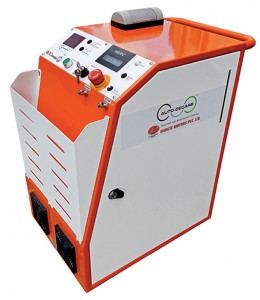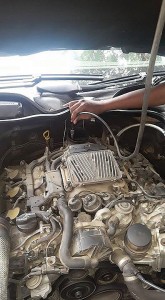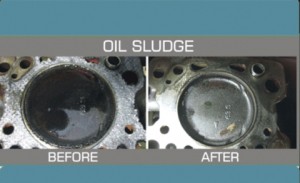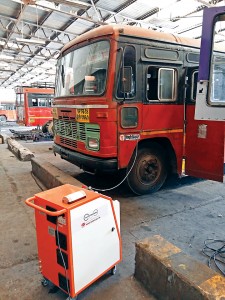A new de-carbonising process claims to enhance efficiency and reduce emissions.
Story by:
Ashish Bhatia
Delhi is grappling with pollution levels that far exceed the permissible limits. Mumbai is not far behind either. Vehicles seem to attract attention foremost, and irrespective of the fossil fuel they sip. A portion of the vehicle’s tendency to pollute and consume an amount of fuel may lie with the rising carbon deposits in the engine over time. Also dictated by the quality of fuel used, carbon build up over time may lead to loss of power and torque. It may also lead to excess tear and wear of the engine. To generate the needed power more fuel will need to be burnt. This will lead to higher emissions.

Ways to decarbonise
An easy answer to decarbonising an engine until now has been to dismantle the cylinder head and remove the carbon deposit, a job that is labour intensive, costly and time consuming. Then, there are chemicals – detergents essentially, that are used to decarbonise an engine without going to the extent of dismantling the cylinder head. There are decarbonising agents that are termed as gasoline additives, foaming engine conditioners and oxy-hydrogen decarb machines that claim to introduce a specifically measured mixture of oxygen and hydrogen into the engine to unsettle the carbon deposition through complete combustion. Entering into an agreement with Taiwan-based General Optics Corporation (GOC), Kolhapur-based Mohite Motors claims to offer an engine decarbonising technique that is the most easiest, most effective and the most harmless ever. Called Auto Decarb, the technique uses pure hydrogen (99 per cent) to de-carbonise, de-tox and de-sludge the engine. Auto-Decarb involves a machine that produces pure hydrogen by consuming water. This is done through a patented process that involves a core with efficient electrolyser stacks. Laced with a bright control panel, the Auto-Decarb machine has a control panel that has system auto check, pressure safety control, hydrogen leakage detection, over pressure detection and over temperature detection functions. According to Richard Miab, President, GOC, the Auto-Decarb machine uses Proton Exchange Membrane (PEM) technology to produce pure hydrogen. To decarbonise the engine, the machine supplies hydrogen into the combustion chamber through the inlet manifold.




How it works
Hydrogen is known to remove impurities on the solid surface, and finds use in a diverse range of applications like archaeological, semiconductor and electronic industries. Hydrogen atom reacts with carbon, silicon and oxygen atoms to form volatile molecules in order to remove the impurities from the solid surface. When introduced in an engine, hydrogen will be dissociated to active hydrogen (H) due to the temperature of the engine. The active hydrogen reacts with the sludge, carbon deposits and oxide substance in the engine. Sludge and carbon deposits turn into gas after reaction with active hydrogen or are re-burnt into carbon monoxide or carbon dioxide and water vapour before discharging from the exhaust. All that the operator of the Auto-Decarb machine has to do is disengage the air filter hose attached to the intake manifold and attach the Auto-Decarb hose instead. It does not take special training to do so. A flame-out detector needs to be connected with the battery and shuts down hydrogen production in the machine if the engine stalls. There’s a safety mechanism built in. The machine runs for a cycle of 40 minutes, and according to Dr. Shrikant Patankar, Advisor, Mohite Motors, is caliberated as per the vehicle’s engine capacity and kilometre reading. In case of a diesel engine, the dislodged carbon deposits are expelled from the exhaust in the form of black smoke. In the case of a petrol engine, the expulsion is in the form of water.
ARAI certified
Certified by ARAI according to Dr. Patankar, the Auto-Decarb machine was tested by Central Institute of Road Transport (CIRT). “We approached Brihan Mumbai Electric Supply & Transport Undertaking (BEST) and Maharashtra State Road Transport Corporation (MSRTC) for the testing of the Auto-Decarb machine on their buses. Decarbonising was carried out on MSRTC’s fleet of 61 buses at the Vallabhnagar depot at Pune. Post the treatment, tests were carried out. A marked improvement in the performance was found. Also, a jump in fuel efficiency by 1 km per litre was observed. On a Natals duly calibrated machine, pollution levels were found to have dropped by 60 to 68 per cent,” averred Dr. Patankar. He mentioned, that decarbonising is recommended for vehicles that have run for over 40,000 km. He also drew attention to an Auto-Decarb machine specifically developed by GOC for Indian two wheelers. Mohite Motors is currently testing this machine and hopes to make it available in some time. Discussions with automobile manufacturers are on to have the machines endorsed for use at the dealers.
Apart from the machine specifically developed for two wheelers with inputs from Mohite Motors, the Auto-Decarb machines include a heavy-duty machine for decarbonising the engines of trucks, buses, construction equipment and other such heavy-duty applications. Such a machine would cost Rs.30 lakh approximately according to Dr. Patankar. A machine for passenger vehicle would cost Rs. 15 lakh approximately. The machine for two wheelers would cost Rs. 5.5 lakh approximately. A two wheeler decarbonising cycle at the other end, will cost Rs.500; for passenger vehicles will cost Rs.3,000, and will cost Rs.6,000 for commercial vehicles or heavy-duty engines. With the production of pure hydrogen eliminating the risk of implosion which is a possibility in case of contamination with oxygen, the Auto-Decarb machine looks interesting. Especially for the fact that it promises to do away with the need to dismantle the cylinder head, a job that is labour intensive as well as expensive. The best part about the Auto-Decarb machine is its ability to reduce emission levels. It is on this basis, said Dr. Patankar, that they have approached the government to give them duty benefit. If a duty benefit is had, the machine could cost less by up to 40 per cent.”




















